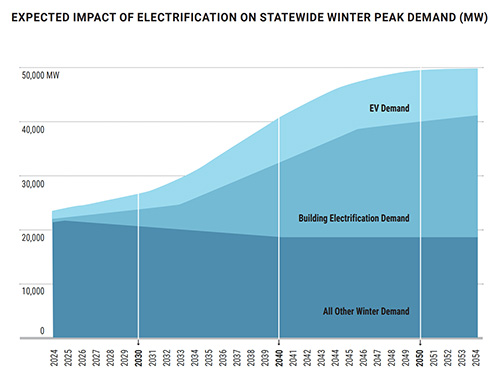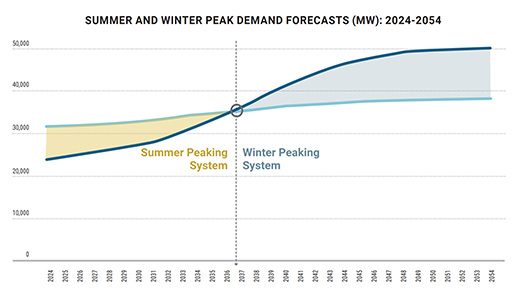Fuel Security: A Growing Winter Reliability Concern

With winter electricity demand on the rise, a new electric system planning rule was put in place in 2024 to model gas availability for generators during colder months.

In recent years, the NYISO’s long-term demand forecasts have found that New York will become a winter-peaking state in the mid-2030s, a shift attributable in part, to the expected electrification of the residential and commercial building sector. Limitations on fuel delivery systems in the winter has emerged as a growing risk factor. Effectively managing and forecasting energy supplies, or fuel security, will be increasingly important for maintaining grid reliability in winter.
Historically, electricity demand in New York has been highest in the summer. That’s changing, however, with future load forecasts showing winter demand rising by as much as 1,200 megawatts annually by 2030. This presents new fuel availability challenges for grid planning and operations.
For health and safety reasons, natural gas is prioritized for residential consumers to heat their homes in the winter. As a result, winter-time gas constraints affect all generators that rely on natural gas with the impact being mitigated for dual-fuel units, which can switch to oil as a backup fuel when gas demand is high.
With natural gas serving as the primary fuel for more than 60% of the generating capacity in the state, potential fuel constraints can have serious consequences for grid reliability. Most of the gas-powered generation located downstate is dual-fuel — meaning it can switch to oil in times of gas supply constraints. This flexibility supports system reliability during extreme weather events like the recent polar vortex.

The state’s clean energy goals seek to decarbonize the electric grid by 2040, and natural gas will continue to be necessary to maintain grid reliability during the transition period. Fuel security is also critical for the ongoing electrification of housing and transportation, as gas-based generation helps power heat pumps and electric vehicles.
With winter peak demand approaching summer peak demand levels within the next decade, the winter reliability margin is shrinking, underscoring the need to more accurately account for winter operating conditions in reliability planning models.
The New York State Reliability Council, which establishes rules used to assess grid reliability, identified the need to model winter operations under conditions in which generators have limited access to natural gas. A new rule, adopted in May 2024, seeks to model future winter system operations under reasonably expected conditions.
The rule is reflected in the findings of the NYISO’s 2024 Reliability Needs Assessment. In that report, NYISO planners modeled the system with the assumption that 6,400 megawatts (MW) of gas-only generation will be out-of-service during winter peak conditions due to supply disruptions and system constraints. This assumption contributes to the forecasted narrowing of reliability margins across the RNA’s study horizon.
Issues associated with maintaining grid reliability during the winter months are expected to become more acute in the coming years. As Winter Storm Elliott demonstrated, the connection between fuel security and grid reliability is an important topic that requires more attention and discussion. The North American Electric Reliability Corporation recently raised concerns about fuel security during extreme winter weather events and called for increased coordination among all stakeholders to maintain reliability.
